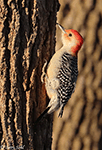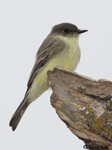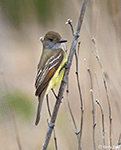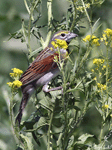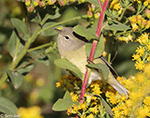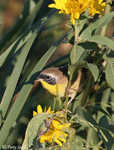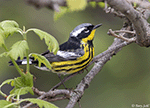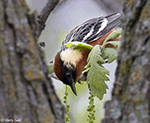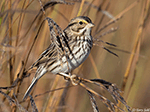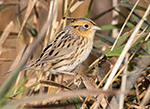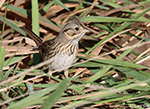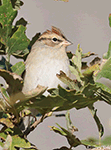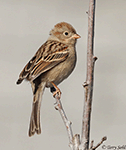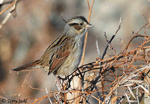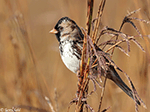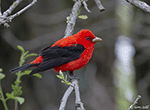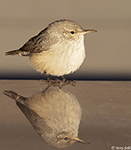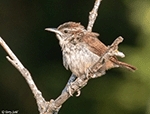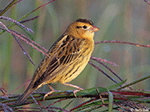South Dakota Birding Hotspot
Good Earth State Park
Lincoln County
| Click on points to view actual ground photos and birding information for those locations. Use the Google tools to switch between road maps, terrain, or satellite images. |
Directions:
Good Earth State Park, formerly known as "Blood Run", is located southeast of Sioux Falls along the South Dakota/Iowa border. The entrance to the park is 2 miles east of Highway 11, just south of 269th street. If coming from Sioux Falls, simply take Highway 11 south out of town. Highway 11 is the north/south road that is just east of Dawley Farms (Target, Kohl's, Century Theater, etc.) and the Menard's/Perkin's area. As you're headed south and apparently leaving town, keep your eyes out for signs pointing you to Good Earth to the East. You'll turn east on 269th street (Highway 102), and follow it east for 2 miles. You'll hit a "T" intersection, and turn right (south). The entrance to Good Earth State Park is 1/4 mile south, on your left (east side of the road).
The image here represents color aerial photography of the Good Earth State Park area, as seen on Google Earth.
Geographic Coordinates:
-
Main entrance to park: 43° 29' 9.41" N, 96° 36' 32.2" W
-
Visitor's Center: 43° 28' 37.88" N, 96° 35' 39.82" W
Description:
Good Earth State Park, formerly often referred to as "Blood Run", is a large state park southeast of Sioux Falls. It lies at a site advertised as one of the oldest sites of long-term human habitation in the United States, with the peak of activity occurring between 1300 and 1700. Its served as an important settlement and trading site, with the Omaha, Ponca, Ioway, and Otoe Native Americans using the space (SD Game, Fish & Parks). The site was named a National Historic Landmark in 1970.
Good Earth is one of the larger parks in South Dakota, covering over 650 acres. Criss-crossing that land is several miles of well-developed trails. Unlike many other parks in the state, Good Earth State Park is NOT developed for camping, and remains more "wild" than most other parks in the region. The most popular activities in the park are hiking, and...birdwatching!! There's also a new (2017), extremely nice visitor's center at the park, offering some great information on the history of the region.
The park is close to Sioux Falls and is becoming increasingly popular for hiking and jogging, and given the proximity to Sioux Falls, the parking lot is increasingly often full in the summer or in the shoulder seasons when the weather is nice. The big attractions from a birding standpoint are:
- The size: With several miles of trails, it's usually easy to find a quiet part of the park to enjoy, despite the park's increasing popularity.
- Access: For anyone in the Sioux Falls area, it's a quick drive to get to.
- Variety of habitats: Big stands of forest aren't exactly common in South Dakota, and this is one of the largest contiguous blocks of forest in the area that's easily accessible to the public. But it's not just forest, as there are also large, very well managed grassy areas, areas of thick shrubbery, areas of herbaceous vegetation and wildflowers, and aquatic habitat along the river. Many types of habitat = many potential types of birds!
Birding can be good in all seasons. As is often the case in the area, winter birding is sometimes slow, but you'll have the advantage of having much of the park to yourself, dependent upon weather and trail conditions. Spring, summer, and fall birding can be...utterly spectacular. The proximity to the Big Sioux River corridor, the extensive forested lands, the broad areas of other habitat...all draw large numbers of migrant birds, and all the typical eastern deciduous forest birds of the US can potentially be found here. May is by far my favorite month to visit, as mid-May often marks the peak of the warbler and songbird migration. Spring migration is often unpredictable, but to give you an idea of the spring birding potential, in both the spring of 2019 and 2020, visits to Good Earth State Park in mid-May resulted in almost 20 unique warbler species in one day!
Points of Note (Click on numbers below or on the map to see photos of the locations):
NOTE: A trail map for Good Earth State Park is available from South Dakota Game, Fish & Parks (click here). For an annotated version of the SD-GFP map that graphically depicts the locations of the six points listed below, click here.
Point 1 - Entrance Road: The birding at Good Earth State Park starts the moment you enter the park. Good Earth has a rather unique entrance, a long, winding paved road running over a mile, meandering from the entrance through a truly wonderful strip of grassland habitat (Point 1). On both sides of the entrance road, there's a variable width of grassland habitat that's not the typical, invasive smooth brome grass that's replaced native grasses throughout much of the state. The grassland is a nice mix of native grasses that can be one of the most productive grassland birding areas near Sioux Falls. I love birding for sparrows in the fall, when we can get a really terrific variety of species, and the area around the entrance road to Good Earth State Park is one of my favorite "Sparrow patches" in the area. Other typical grassland species can also be found here. After a long, South Dakota winter, the entrance road to Good Earth is a great place to slowly drive through with the windows down if you want your first spring "fix" of the wonderful spring sounds of singing Western Meadowlarks, Bobolinks, or Dickcissels. All great...but...OH, the fall sparrows!
Point 2 - Visitor's Center: At the end of the entrance road is a parking lot, and the extremely well designed visitor's center. The Visitor's Center area itself is worth poking around a bit, given that there are two feeder complexes very close to the parking lot and visitor's center (Point 2). The first of these is on the south end of the parking lot, just outside the entrance to the visitor's center. The second feeder complex is bigger and is on the east side of the visitor's center, along the start of the trail system. Both are constantly maintained and are good places to pause and see who's coming to the feeders that day. With the feeders filled with various seeds and big chunks of suet, there's often a good variety of feeder visitors. There's also usually a hummingbird feeder or two hanging on the back side (east side) of the visitor's center, a good place to look for Ruby-throated Hummingbirds from May through September. The area around the visitors center is also landscaped with various flowers, plants, and shrubs, and I've had surprisingly good luck finding interesting birds in that vegetation, particularly during the fall migration.
Point 3 - Grassy Loop: Whew! By now you haven't left the area of the parking lot and the visitor's center, and your bird list for a visit may already be extensive, given everything you saw on the entrance road on the way in, and what you found around the visitor's center! Finally now, we're getting to the main attraction of the park for both hikers and birdwatchers...the incredible trail system. The trail system starts on the backside of the visitor's center, taking you past the 2nd feeder complex, and following the edge of some trees to the first decision of the day...which way do I go on the trail when you get to the first trail intersection? When you get to the first intersection (just two choices on direction), note the area in front of you...a large, absolutely wonderful oasis of grassland, herbaceous vegetation, and wildflowers, surrounded by dense forest on all sides. This big grassland/vegetation area (Point 3) is one of my favorite locations in the park. It's such a rich diversity of plant species within what's a loop that completely encircles the grassy area, and it's that rich plant diversity that can attract a wide variety of birds. Typical grassland species can be found here, but given the proximity of the forest that surrounds it, there are also forest species I often find that are surprisingly foraging in the grassy/herbaceous area. It's not often, for example, that I find multiple Indigo Buntings or Great-crested Flycatchers foraging out in an open grassy area, but I have seen them here on multiple occasions! It's also an absolutely terrific spot to look for butterflies and other buggy critters, given the number and variety of wildflowers found here in the summer months.
Point 4 - Overlooks: On the east end of the big grassy loop (Point 3), there are a number of side paths you can take. Three of these lead to, well, three wonderful spots for both birding, and for great overlooks of the river and the riparian area below. On the east end of the loop the sidepaths take you to three different overlook decks (Point 4, with all 3 overlooks shown on the map above) that overlook the river to the east, and Iowa on the other side of the river. Why do I love these overlook decks? Not to look at Iowa (hey, nothing against Iowa, although as a born and bred Husker myself, I've been trained since birth to dismiss all things Iowa). No, the attraction is the placement of the decks, at the top of the bluff, with steep banks leading down to the river. The placement is such that the decks offer great access to the surrounding forest canopy. At each one of the three decks, you're basically right next to the surrounding canopy of Burr Oaks and other species. Simply hanging out on the decks in the spring, when waves of migrant warblers and songbirds are often moving through, is often a great way to get good, close, eye-level views of species you normally have to crane your neck upward to see as they forage in the forest canopy.
Point 5 - Edge Habitat: After visiting the overlook decks, I usually head to another favorite area in the park, found on a trail that heads northeastward from the "Grassy Loop" in Point 3. The trail (called the "Basswood Trail" on Good Earth trail maps) moves through mostly forested habitat before eventually heading downward towards the river itself. The general area at the end of the Basswood trail, Point 5, is an area where I've always had great luck birding. Point 5 is a junction that can lead you to multiple habitat types (and thus, a variety of bird species!). You've just come down a hill with dense forest on all sides, and potentially encountered some wonderful forest species. You're now at the forest edge, opening up opportunities for many "edge" habitat specialists. This location, for example, is an area where Carolina Wrens have been seen in recent years (South Dakota is the far northern edge of their range). If you continue out towards the river, you're walking across a lowland floodplain that is subject to periodic flooding, leading to an everchanging landscape of grasses, shrubs, and vegetation that loves moisture. This often scrubby looking vegetation offers yet more potential species, and your eventual arrival at the river itself offers the opportunity for even more species.
Point 6 - Forested Ravine: Finally, there's one more trail I love to take, with the start of the trail on the southern side of the "Grassy Loop" (Point 3). This trail, called the "River Trail" on Good Earth trail maps (Point 6) trail starts at the edge of the forest, and snakes downward along a heavily forested ravine, towards the floodplain down below. The ravine itself, with thick undergrowth and a tall forest canopy above, can be absolutely incredible for birding, particularly in the spring months when migration is in full swing. There are spring days where I may find myself hanging out on this trail for hours, lost in the variety and sounds of all the birds moving through the forest canopy. It's NOT a great location for bird photography! The canopy is high above, so this is very much a place for birding with binoculars, but the variety and number of birds is often very high.
There's a lot more of Good Earth State Park to explore, as the 6 "featured" locations and trails above don't even touch the southern 1/3rd of the park. Given that the locations above usually are so "birdy" that I can spend most of a day walking my "usual" route, I need to expand my horizons and explore the southern part of the park more than I have to date!
Birds of Note:
Variety is the spice of life! And if there's one thing that Good Earth State Park can generally offer, it's a variety of habitats, and a variety of birds. Let's start with the grassland-lined entrance road, where most of the typical grassland species can be found. This includes the wonderful tinkly-sounding Bobolink, Western Meadowlarks, and Dickcissels...three species which epitomize the sounds of summer birding for me. But the big attraction for me in this area are the sparrows, particularly during the fall migration when it seems like every possible sparrow species in South Dakota may potentially be found here! This includes the typical, more common migrants through the state (Lincoln's Sparrows, Harris's Sparrows, White-crowned Sparrows, White-throated Sparrows) and those that both breed here and migrate through the state (Song Sparrows, Clay-colored Sparrows, Field Sparrows, Chipping Sparrows). One of my favorite sparrow species are often found here, a species that's sometimes hard to find and observe in the state (Leconte's Sparrow), while true South Dakota rarities have also been found here (Henslow's Sparrow).
When I think of Good Earth State Park, the other attraction for me...spring warblers. If you name a warbler species that has been found in South Dakota, it's likely been catalogued at Good Earth. The spring of 2019 and 2020, for example, were both absolutely spectacular for warblers in the park, with a real chance to see up to 20 different warbler species in a day. In 2020, it was the year of the American Redstart , with...dozens...seemingly found around every corner in the park. Common Yellowthroat are also around in spring, summer, and fall, by the dozens (hundreds?), particularly in the scrubby lowlands near the river. The ever-present Yellow Warblers are also always around in force. However, it's the migrants that are the big attractants. You'll always find good numbers of Orange-crowned Warblers, Tennessee Warbler, and Yellow-rumped Warblers in the spring. But keep scanning those waves of warblers moving through the canopy and you may find Blackpoll Warbler, Black-and-white Warbler, Wilson's Warbler, Canada Warbler, or Palm Warbler, or some that tend to be a little less common in Mourning Warbler, Chestnut-sided Warbler, Northern Parula, or Black-throated Green Warbler. Bay-breasted Warblers and Blackburnian Warblers are two species I always feel fortunate to find in the spring,
Summer brings bird species that are common in deciduous forests of the Eastern US, but aren't quite as common in a South Dakota landscape dominated by agriculture. Here, however, is a mecca in summer for finding Rose-breasted Grosbeaks, Baltimore Orioles and Orchard Orioles (all very common). Gray Catbirds and Brown Thrashers are also quite common in the park, particularly Catbirds (as evidenced by the mewing sounds that sometimes seem to be coming from all over!). You may see a flash of blue or red in the forest canopy, and see Indigo Buntings and Scarlet Tanagers. I always seem to see Ruby-throated Hummingbirds in the park, and always keep my eye out to find that elusive nest. Vireo species, both Cuckoo species, House Wrens by the dozens...it can also be a noisy park, particularly in the spring when all are singing!
Winter birding is generally slow around Sioux Falls, with species variety obviously far below what can be found in other seasons. However, there are some hardy denizens of Good Earth State Park that you could see in any season. High among these are the woodpeckers, with good numbers of Red-bellied, Downy, and Hairy Woodpeckers, all of which can often be seen at the feeders near the visitor's center. White-breasted Nuthatches are common all year, while Red-breasted Nuthatches and Brown Creepers can be found in migration and in winter. I have found three species of owls in the park, Eastern Screech Owls, Great Horned Owls, and more rarely, Barred Owls, a true rarity in South Dakota (although sightings seem to be increasing in recent years).
In short, with the variety of habitats in the park, there's a great variety of species you could potentially find on a trip!
Other Birding Locations (sorted by distance):
- Outdoor Campus in Sioux Falls (12 miles)
- Beaver Creek Nature Area (~15 miles)
- Dewey Gevik / Wall Lake (~22 miles)
- Newton Hills State Park (~25 miles)
- Western Minnehaha County (~35 miles)
- Madison Waterfowl Production Area (~60 miles)
- Dakota Nature Park, Brookings (~65 miles)
- North Alabama Bend (~70 miles)
- Lake Thompson Area (~85 miles)
- Gavin's Point Dam (~95 miles)
- Presho Area (~185 miles)
- Fort Pierre National Grasslands (~205 miles)
- Pierre / Oahe Dam Area (~235 miles)
- LaCreek National Wildlife Refuge (~315 miles)
Additional Information - Good Earth State Park:
- SD Game Fish & Parks Home Page - Good Earth State Park
- SD Game Fish & Parks - Trail Guide - Good Earth State Park
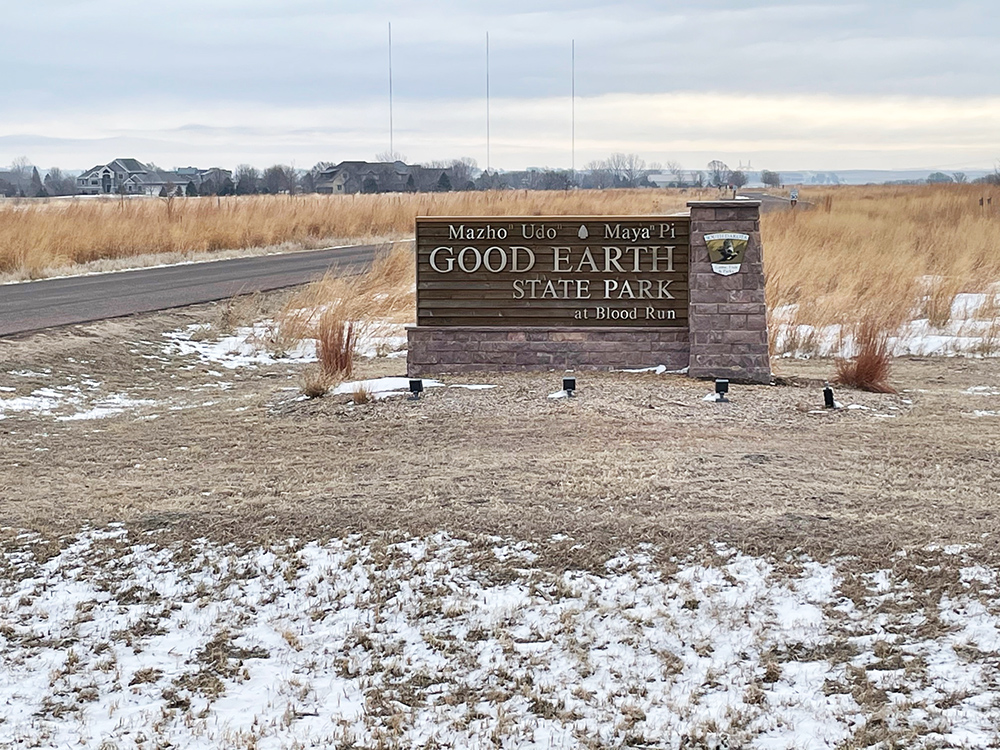

Good Earth State Park trail map (Click here - SD-GFP site) with birding points of interest overlaid
